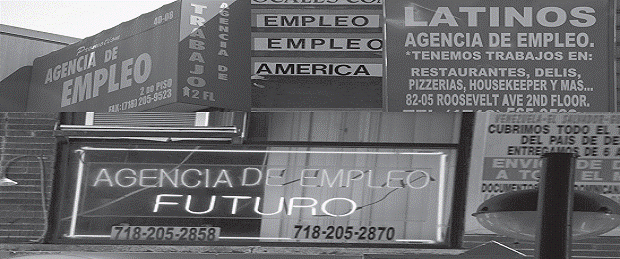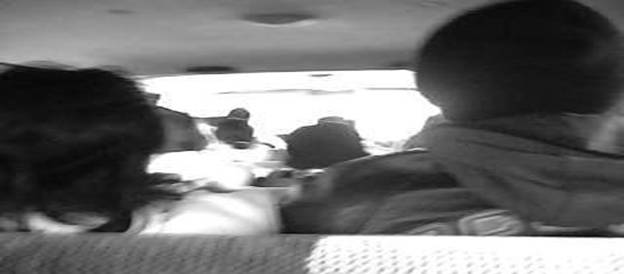Editor’s Note: Labor has been under assault from all sides. Sadly, this has created a false dichotomy between the rights of migrant workers (be they documented or otherwise) and those of US workers. In this investigative piece, David Van Arsdale reveals an economy increasingly dependant on flexible labor, which seems to threaten the security of work for us all. In sharing this experience, we hope to spark a fruitful debate on the potential of solidarity of workers across national boundaries.

Here in Upstate and Central New York the general public is aware that employers are increasingly dependent on immigrant workforces. We see and hear that headline regularly. We are less aware, however, of how migrant workers get jobs and the function of the work they do at workplaces. In a two part series for the Peace Newsletter, I am sharing my experiences working “undercover” with immigrant Latino workers through staffing agencies that specialize in dispatching them to employers in New York and sometimes neighboring states. I invite you to follow my experiences.
Pimping migrant workers
A temporary worker should never oversleep. This was my thought as I hit the snooze button on my alarm clock two or three times. By the time I awoke, it was half past seven in the morning—far too late, I thought to myself, to find a construction or factory job through the staffing agency in Harlem through which I was working. I decided to try anyhow. I arrived to discover a mostly-vacant waiting room. There were only two other workers waiting and both of them informed me that most of the jobs were dispatched before seven, as I had suspected. Juan, a twenty-four-year-old Nicaraguan who lives in the housing projects across the street from the agency, asked me if I knew of any other agencies offering work. I asked if he wanted to come with me to try the agencies in Queens, in the Latino neighborhoods. Juan and I became quick friends, we jumped on the subway and headed for Queens.
As Juan and I walked down a major street in our construction clothes, solicitors approached us from many directions, handing us flyers with directions to their respective Agencias de Empleo, employment agencies. The flyers promised work in construction, restaurants, cleaning, factories, delivery, offices, and housekeeping. Juan and I made our way from one agency to the next. One told us that we could deliver Chinese food for five dollars an hour. Another told us that we could lay bricks for ten dollars an hour. Still, another offered us a painting job for seven dollars an hour. All of these agencies told us there was a charge for their services. The latter two said that the charge was one hundred dollars, and the agency offering the Chinese food delivery job was only going to charge us fifty dollars. Neither Juan nor I wanted to pay this much or go in debt to the agencies, which is also an option. Therefore, we decided to try our luck someplace else.
We walked outside and spotted a roundup of people getting into two large cargo vans. We approached the workers and asked them if they were going to work. They directed us to the agency dispatching the jobs. A woman behind a desk at the agency explained that the vans were headed to a food factory in Upstate New York, and that we were welcome to work if we wanted the job. The shift was from 4 pm to 12 am. The job paid eight dollars an hour. The only charge to us was for transportation to and from the factory, which was ten dollars apiece. We gave the woman our names and proceeded to jam our bodies into the already packed vans.
I took a seat in the back. There were four of us on each of the bench seats made for three, and two others sat on the floor. In the hour that it took to get to the factory, I learned that most of the workers in the van were recent immigrants from Mexico. There were also a couple of workers from Puerto Rico and Ecuador. A woman sitting to my right was from Peru. Their ages appeared to range from around sixteen to sixty-five. Juan, two others, and I, were the only men in the van. One of those men, Pedro, sitting to my left, had worked at the food factory on prior occasions and coached Juan and I on what to expect and how to behave.

From the back of the van – on our way to the food factory.
The picture is blurry so as to obscure the identity of workers
in this underground economy. Photo: David Van Arsdale
At the food factory
We arrived at the factory ten minutes before the start of the second shift. Juan and I followed Pedro into the mens’ locker room, where Pedro told us to take off our hats and jackets. We then followed him into the dressing room, where we put on white lab jackets and proceeded to walk onto the factory floor. There were three rather official-looking men waiting to greet us, each wearing a blue jacket like our white jackets, only theirs had their names and the company name printed on them. There was also a man from the Food and Drug Administration wearing an official “FDA” hard-hat and jacket. The company men welcomed us and asked if we understood English. We nodded yes. One of the men asked us, “Have you ever worked in this factory before?” We shook our heads as he went onto explain that there was really nothing to it. “Just a few rules,” he said. “No jewelry, no chewing gum, no cell phones. Hair and beard nets are required in the factory, and always wash your hands every time you walk into the factory.” He showed us how to put on the hair and beard nets, took Juan to one end of the factory, and had another manager take me to the opposite end where I was to work alongside a thirty-foot conveyer belt. “This is what you are going to do,” the manager explained, and he showed me how to spread butter on one half of a thinly sliced piece of dough about twelve inches long as it quickly passed by me on the belt. After the dough was buttered, a woman to my right positioned a piece of cheese in raspberry glaze on the unbuttered half. Then, women to her right folded the dough into rugelach (a type of pastry). Other workers at the end of the line packaged the rugelach into plastic containers and then stacked the containers on the skid at the end of the line.
“This seems easy enough,” was my first thought. My brush went from the large pan that held the hot butter on my right to the conveyer belt where I buttered the half pieces of dough. But the strips of dough came one right after another. I buttered about two pieces of dough every three seconds. After thirty minutes of buttering, my right hand began to cramp. In an attempt to switch to my left hand I got backed up, which caused the women further down the line to discipline me a bit. There was a line on each side of the conveyor belt, both performing the same duties. The woman applying butter to dough across from me looked at me and smiled. “You’ll learn to use your left hand,” she said. “You’ll need to keep your right hand from cramping.” This woman, Rosa, was nineteen years old. She was relatively new to New York City and talked about her dream of going to community college to become a nurse. She told me that she was going to get her GED next year after her English improved, and then apply to college. I told her that it was a good plan and explained she did not need a GED to go to community college, information that instantly seemed to make her my friend.
As Rosa and I buttered the dough that rushed by, she taught me some useful survival techniques that helped me keep pace with the belt. “You hear the rhythm of the factory?” she asked, referring to the thumping noise made by the dough-making machine on the other side of the factory. “You can brush to that rhythm and when that gets boring,” she explained, “you can sing a song to the rhythm or just dance a little.” Rosa was right. Keeping pace with the rhythm helped the time pass and helped me stay on pace with the conveyer belt. The hardest time to keep the rhythm, however, was in the moments when my eyes wandered to the clock overlooking the factory floor. Of course, one’s eyes go there for answers to questions like, “how long till the next break?” Or, “how much time has passed since I last peeked at the clock?” Breaks at the factory happen twice in an eight-hour shift, and each break is fifteen minutes long.
The assembly-line workers in the factory come from agencies all over the New York metropolitan area. The factory does not know the names, ages, or any personal information about the workers, nor does it care to. It calls the agencies to get whatever number of workers it needs. For the factory, there are many benefits to working with the agencies, perhaps the greatest of which is being able to flexibly employ a dedicated workforce. When demand is strong, the company calls the agencies and they provide the workforce. When the freezers are full, a sign that demand has decreased, there’s no need for the call. This way the company’s payroll corresponds to the ebbs and flow of production. Of course for the workers, when demand is slow, so too is their opportunity for work and pay.
Part II of this essay will appear the September issue of the Peace Newsletter.





